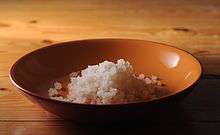Tibicos
%2C_after_2_days.jpg)

Tibicos are a symbiotic culture of bacteria and yeasts held in a polysaccharide biofilm matrix created by the bacteria. As with kefir grains, the microbes present in tibicos act in symbiosis to maintain a stable culture. Tibicos can do this in many different sugary liquids, feeding off the sugar to produce lactic acid, alcohol (ethanol), and carbon dioxide gas, which carbonates the drink.
Tibicos is also known as tibi, water kefir grains, sugar kefir grains, Japanese water crystals and California bees, and in older literature as bébées, African bees, ale nuts, Australian bees, balm of Gilead, beer seeds, beer plant, bees, ginger bees, Japanese beer seeds and vinegar bees,[1]
Tibicos are found around the world, with no two cultures being exactly the same. Typical tibicos have a mix of Lactobacillus, Streptococcus, Pediococcus and Leuconostoc bacteria with yeasts from Saccharomyces, Candida, Kloeckera and possibly others. Lactobacillus brevis has been identified as the species responsible for the production of the polysaccharide (dextran) that forms the grains.[2][3] Pidoux (1989)[3] also identifies the sugary kefir grain with the ginger beer plant. Certainly opportunistic bacteria take advantage of this stable symbiotic relation which might be the reason for the many different names/distinction in the scientific literature. Different ingredients or hygienic conditions might also change the fungal and bacteriological composition, leading to the different names. People who do not wish to consume dairy products may find that water kefir provides probiotics without the need for dairy or tea cultured products, such as kombucha. The finished product, if bottled, will produce a carbonated beverage. It will continue to ferment when bottled thus producing more carbonation—so bottles need to be capped loosely and allowed to breathe, or they may become explosive.
Origin
At least two references in the scientific literature relate to the origin of the tibi. According to the first paper, tibicos forms on the pads of the Opuntia cactus (from Mexico) as hard granules that can be reconstituted in a sugar-water solution as propagating tibicos. The second paper refers to a specific bacteria cultured from known stocks with properties similar to those in tibi.[4][5]
Tibicos are used to brew a variety of tepache known as tepache de tibicos.[6] The ginger beer plant is also a form of tibicos. Kebler attests that they were used in Kentucky circa 1859 to brew a "home drink" and were referred to as "japanese beer seeds".[1]
Preparation
.jpg)
The basic preparation method is to add tibicos to a sugary liquid and allow it to ferment 24 to 48 hours. A typical recipe might contain the tibicos culture, a citrus fruit and water. It is important to not use ingredients that will inhibit the fermentation, such as chlorine in tap water or preservatives in dried fruit (sulfites). The fruits used may be changed and mixed to create different flavors.
Additional precautions should be taken to keep the cultures healthy. The use of reactive metals such as aluminium, copper, or zinc should be minimized, since the acidity of the solution can draw these metals out, damaging the culture. The beverage should not be stored in metal containers, as these may leach into it over time. Instead, use stainless steel, plastic, non-lead-glazed ceramic or glass containers. Culturing grains in a glass jar and using clean stainless steel or plastic utensils when handling the grains is recommended.
See also
References
- 1 2 Kebler, L. F. (June 1921). "California bees.". J. Pharm. Sci. 10 (12): 939–943. doi:10.1002/jps.3080101206.
- ↑ Horisberger, M.; Bauer, H.; Bauer, Heinz (December 1980). "The structural organization of the Tibi grain as revealed by light, scanning and transmission microscopy". Archives of Microbiology. 128 (2): 157–161. doi:10.1007/BF00406153.
- 1 2 Pidoux, M. (June 1989). "The microbial flora of sugary kefir grain (the gingerbeer plant): biosynthesis of the grain from Lactobacillus hilgardii producing a polysaccharide gel". World Journal of Microbiology and Biotechnology. 5 (2): 223–38. doi:10.1007/BF01741847.
- ↑ Lutz, L. (1899). "Recherches biologiques sur la constitution du Tibi". Bull. Soc. Mycol. France. 15: 68–72.
- ↑ Stacey, M.; Youd, F. R. (November 1938). "A note on the dextran produced from sucrose by Betacoccus arabinosaceous haemolyticus". Biochem J. 32 (11): 1943–1945. PMC 1264277
 . PMID 16746830.
. PMID 16746830. - ↑ http://www.cabdirect.org/abstracts/19950314684.html;jsessionid=DC91A19C32DD763E770932398B531AFB